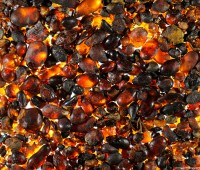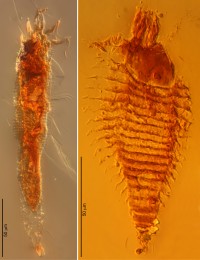Scientists have found two gall mites and a fly preserved in 230-million-year-old Late Triassic amber from the Dolomite Alps in northeastern Italy. These are the first arthropods (a phylum of invertebrates including insects, arachnids and crustaceans) found in amber from the Triassic. Although arthropods appear in the fossil record starting in the Early Cambrian period around 540 million years ago, these are the oldest arthropods ever discovered trapped in amber, 100 million years older than prior examples.
 Researchers gathered thousands of droplets of amber no more than six millimeters long from outcrops on the Dolomites, then spent two years screening each tiny piece for any plant or creature they might contain. If you think this must have been a painfully tedious experience, you think right.
Researchers gathered thousands of droplets of amber no more than six millimeters long from outcrops on the Dolomites, then spent two years screening each tiny piece for any plant or creature they might contain. If you think this must have been a painfully tedious experience, you think right.
“Before preparation, one of the tiny flecks of amber, about 1 millimeter in diameter, wafted onto the floor of my lab,” [David Grimaldi, curator of invertebrate zoology at the American Museum of Natural History in New York,] recalled. “Alex Schmidt and my assistant who did the prep, Paul Nascimbene, spent about three hours on their hands and knees with flashlights. I don’t know how, but they found the speck on the floor hidden in the corner between two lab benches. It was a nerve-wracking time.”
 It’s a good thing they were that dedicated to the task, because out of the 70,000 droplets of amber they analyzed for inclusions, three of them contained the groundbreaking arthropods: one partial midge fly (Diptera) about the size of a head of a pin, and two new species of gall mites. The amber had preserved the head, antenna, four legs and some fragments of the body of the midge fly which taken together were 1.5-2 millimeters in size.
It’s a good thing they were that dedicated to the task, because out of the 70,000 droplets of amber they analyzed for inclusions, three of them contained the groundbreaking arthropods: one partial midge fly (Diptera) about the size of a head of a pin, and two new species of gall mites. The amber had preserved the head, antenna, four legs and some fragments of the body of the midge fly which taken together were 1.5-2 millimeters in size.
The mites were complete and far tinier. One of them, Triasacarus fedelei, is shaped like a worm and is 210 microns long. Due to its body shape and differences in the structure of the mouth, researchers believe it may be an ancestor of modern gall mites. The second mite, Ampezzoa triassica, is even smaller at 124 microns in length. Its shape is more typical of modern gall mites.
 The amber preserved these creatures so well that scientists could examine them in microscopic detail, allowing them to identify minute characteristics like tiny waxy filaments on the surface of Triasacarus fedelei’s body that are thought to have helped protect them from predators, parasites and the elements. Both mites have two pairs of legs like present-day mites.
The amber preserved these creatures so well that scientists could examine them in microscopic detail, allowing them to identify minute characteristics like tiny waxy filaments on the surface of Triasacarus fedelei’s body that are thought to have helped protect them from predators, parasites and the elements. Both mites have two pairs of legs like present-day mites.
One way in which they’re different from their modern relatives is that the Triassic mites must have fed on conifers, since it’s conifer resin that hardens into amber. Today 97% of Eriophyoidea, the group gall mites belong to, feed on flowering plants, which means the mites changed their eating and living habits entirely when the new plant species came on the scene about 140 million years ago.
The Dolomite amber study has been published in the current issue of the Proceedings of the National Academy of Sciences. You can read it here if you have access to a subscription.
What a fantastic discovery. I guess there is always going to be new discoveries in all aspects of geology,archaeology and history in general.Maybe it will need to be re-written for future students studying these subjects.
That’s one of the great things about science: there’s always more to find out.
This is mite-y exciting!
:blush:
You’d better blush. :no:
Another reason to expect these mites fed on conifers is that there were not many angiosperms to eat back then! Our present data suggests that they were just getting their start near the end of the Triassic. Rather a long time to wait for dinner 😉
Yes indeedy. The study also suggests that the gall mites themselves might have been reason the conifers produced so many tiny droplets of sap. Today leaves produce gross gall lumps in response to gall mite infestation. The conifers may have been reacting to the mites by producing resin which captured them and then fossilized for our edification 230 million years later. :boogie:
Although fossil resins of Cretaceous age or older were produced (for the most part) by conifers, there are also more recent resins exuded by angiosperms (for instance Lower Eocene Indian and French ambers, Baltic amber, and Miocene ambers from the Dominican Republic and Mexico). The Triassic amber droplets we found predate the onset of large-scale resin production by many conifers beginning in the Lower Cretaceous — the Triassic drops are uniformly smaller. It is really astonishing that the arthropods we recovered in northern Italy were trapped and preserved in amber that was produced before the Atlantic Ocean formed, before the breakup of the Supercontinent Pangaea, and well before dinosaurs rose to dominance in the Jurassic. — Paul C. Nascimbene
Interesting that even his clothes have a historical story
BENJAMIN MARCUS RAUCHER